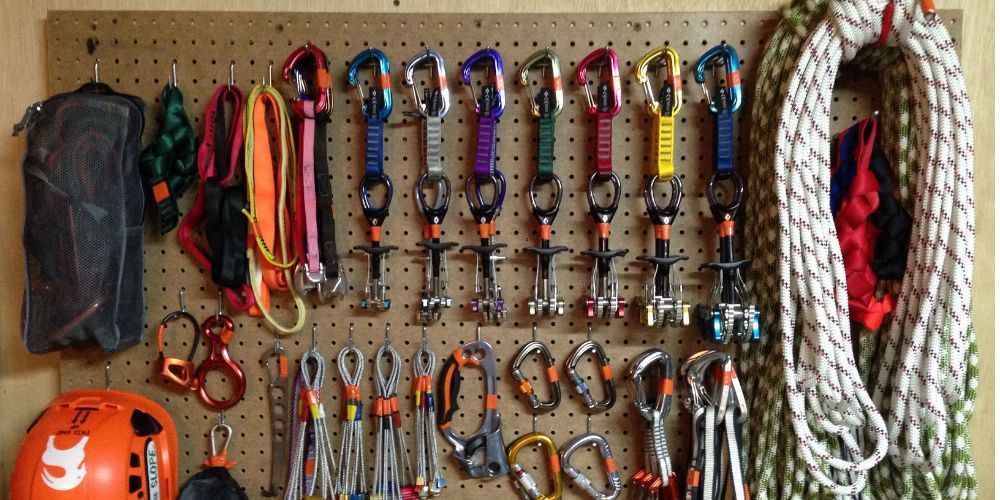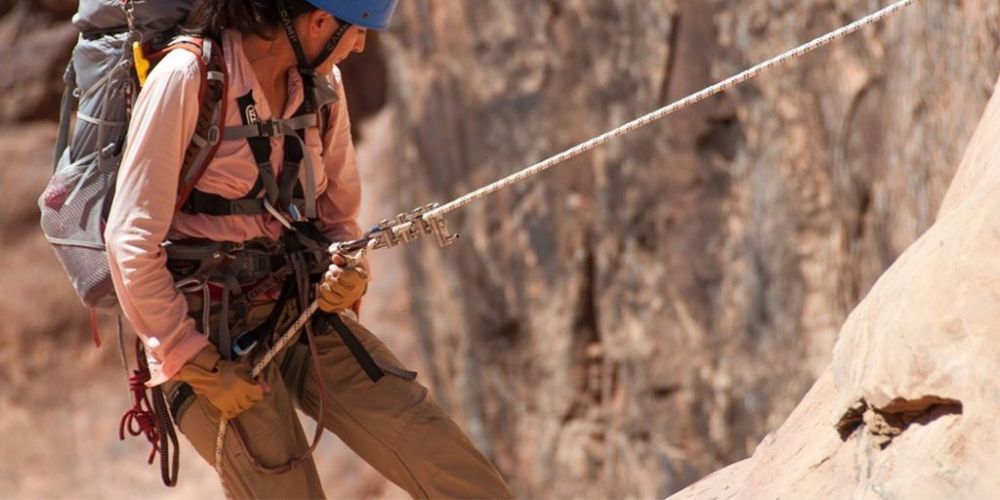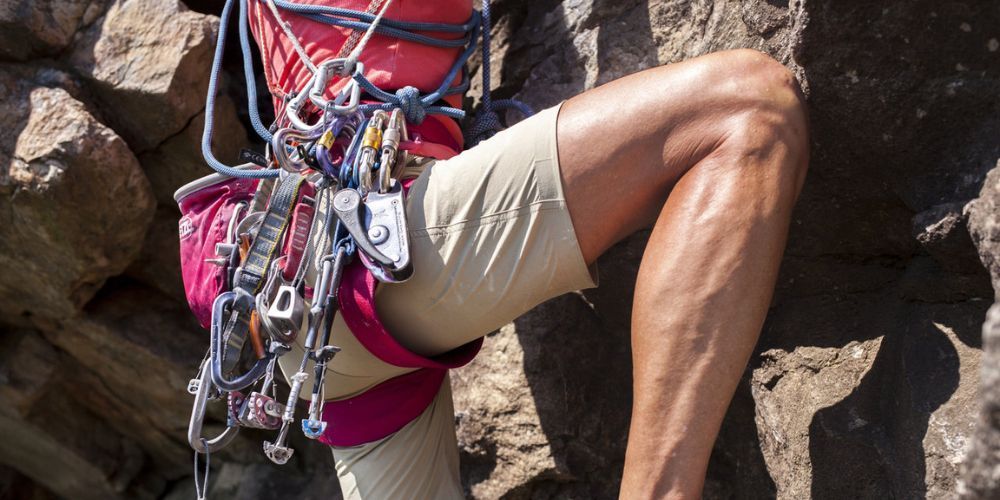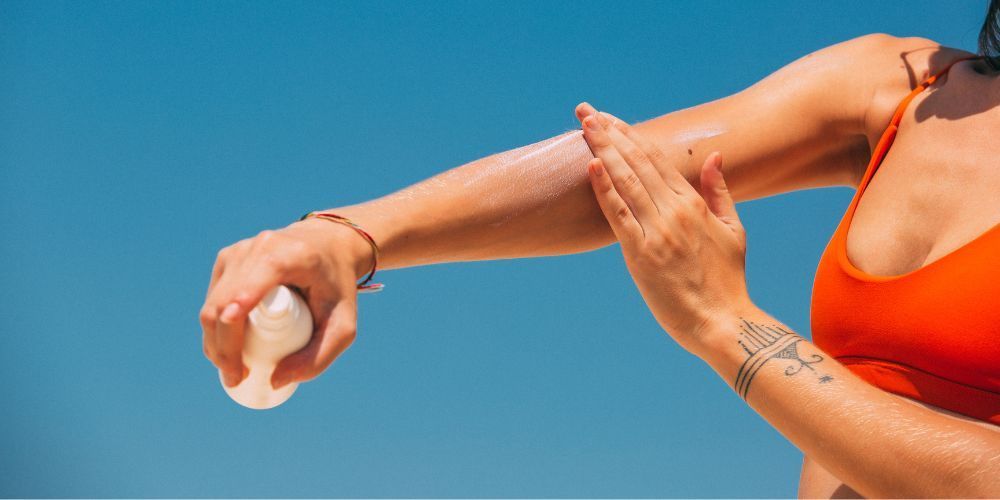Beginner's Guide to Rock Climbing Gear: Essential Equipment and Tips for Beginners
August 1, 2024
Rock climbing is an exhilarating adventure, but getting started requires more than just enthusiasm. The right gear is crucial not only for your safety but also to enhance your overall climbing experience. For a beginner, navigating through countless equipment options can feel daunting.
Understanding this challenge, we have meticulously researched and assembled a comprehensive guide tailored especially for novices. Alongside well-known essentials like harnesses and climbing shoes, we'll also unveil some often-overlooked items that can significantly ease your climbing journey.
Beginner rock climbers should invest in a harness, climbing shoes, a belay device, and a helmet. A good all-around harness such as the
Edelrid Moe for men and
Jayne for women is recommended, along with climbing shoes like the
La Sportiva Tarantulace. These items provide a solid foundation for safe and enjoyable climbing experiences.

Essential Rock Climbing Gear
So, you've decided to take on the challenge of rock climbing. It's an exhilarating endeavor, but safety should always be a top priority. While the allure of the adrenaline rush can be tempting, proper gear is non-negotiable. Let's start with the very first piece: the harness.
Harness
A climber's harness is like a second skin—essential for safety and comfort. When it comes to choosing a harness, fit is crucial. You want it snug enough to keep you secure, yet comfortable enough for long climbs. Additionally, weight distribution plays a vital role in ensuring your freedom of movement while distributing pressure evenly across your body.
When you're just starting out, popular beginner harnesses like the Edelrid Moe for men and Jayne for women are great options to consider. These harnesses are designed with features that cater specifically to beginners, providing both the safety and comfort needed to build your confidence on the wall.
Climbing Shoes
Next up on the checklist—climbing shoes. They're not just regular shoes; they're your lifeline on the wall. Finding the right pair is crucial for maintaining traction and keeping your feet supported during climbs. As a beginner, you'll want a pair that balances comfort and utility.
The La Sportiva Tarantulace is an excellent choice for beginners, offering a blend of comfort and performance ideal for learning the ropes of rock climbing. With proper footwear, you’ll be better equipped to tackle different terrains and challenges.
Carabiners
Carabiners are next on our list—a staple in every climber's toolkit. These nifty devices are crucial for attaching gear safely and efficiently. When selecting carabiners, opt for locking ones to ensure an extra layer of safety during your climbs.
Belay Device
Now, let’s talk about belay devices—an absolute necessity for controlling the rope during climbs. Tube-style devices like the Black Diamond Big Air XP provide simplicity and reliability, making them perfect choices for beginners who are just getting accustomed to handling ropes during their climbs.
Helmet
Safety should never be compromised when it comes to outdoor activities like rock climbing. A sturdy helmet is vital for protecting yourself from falling debris and collisions against rock walls. The Black Diamond Half Dome stands out as a reliable choice for new climbers—it offers excellent protection alongside comfort during longer climbs.
Chalk Bag
Last but not least, we have the chalk bag, a small yet essential tool for enhancing your grip by keeping your hands dry. The Metolius Competition Chalk Bag is designed to be user-friendly, ensuring that you can easily access chalk when needed without hindering your climb.
Successfully navigating the world of rock climbing starts with having the right gear at your disposal. When you invest in quality equipment tailored to beginners' needs, you set yourself up for a safer and more enjoyable climbing experience overall—setting the stage for many successful climbs ahead.
Equipped with this foundational knowledge of essential rock climbing gear, now let's shift our focus to understanding how to select the perfect climbing harness.
Choosing the Right Climbing Harness
When choosing a climbing harness, it's more than just picking any harness off the shelf. It needs to fit just right, distribute weight evenly, and provide adequate support during climbs. Imagine it as a key piece of equipment that ensures your safety and comfort as you scale the rocks. When selecting your climbing harness, there are several essential factors to consider to ensure it meets all your needs.
Fit and Comfort
The harness should fit snugly but comfortably for prolonged use. The waist belt should sit above your hip bones, and the leg loops should be adjustable to accommodate different clothing layers or body sizes. Remember, a proper fit ensures safety and comfort during your climbs. A well-fitted harness will minimize the risk of injury in case of a fall by confidently distributing the force throughout the body. Moreover, if it's uncomfortable, it will make your climbing experience less enjoyable, impacting your performance on the rocks.
Weight Distribution
The key aspect of a good harness is its ability to distribute weight evenly. Unbalanced weight distribution can lead to discomfort during climbs, causing unnecessary strain on specific parts of your body. Find a harness that avoids concentrated pressure points, allowing you to focus on your climb without distractions.
Beginner Recommendations
For beginners, investing in a standard all-around harness that blends comfort, safety, and durability is crucial. The Edelrid Moe for men provides exceptional comfort while ensuring durability, making it ideal for those new to climbing. As for women climbers, the Jayne offers tailored fit and support designed specifically according to female anatomy, ensuring maximum comfort and security during climbs.
It's essential to remember that each harness has its own unique features tailored to different individual needs. Therefore, before making a purchase, try on several options to see which one feels comfortable and secure. Your safety and overall climbing experience greatly depend on this carefully chosen piece of equipment.
Now that we understand the significance of choosing the right harness, let's move on to discuss another critical element of rock climbing gear - the selection of suitable climbing shoes.
Selecting the Best Climbing Shoes
Choosing the right climbing shoes is akin to finding the perfect balance between comfort and performance. Your feet are your foundation on the rock, so it's essential to find a pair that fits snugly, supports your movements, and gives you the confidence to conquer new heights. Here are the key factors to consider when selecting your climbing shoes:
Fit
When it comes to climbing shoes, fit is paramount. You want them to be snug enough to provide support and sensitivity, but not so tight that they cause unnecessary discomfort. Your toes should lightly curl inside the shoe, ensuring a good grip on holds, but still allowing mobility. It's all about finding that sweet spot where you feel connected to the rock without sacrificing comfort.
Keep in mind that different brands and models may have variations in sizing, so trying on several pairs and testing them out by standing on tiptoes or performing small movements can help you determine the most suitable fit for you.
Type of Climbing
The type of climbing you plan to pursue will influence your choice of climbing shoes. For beginners looking for versatility and comfort, all-around shoes like La Sportiva Tarantulace are an excellent option. These shoes offer a balance of support and comfort, making them suitable for various types of climbs—whether it's at the gym, crag, or bouldering.
If you're aiming to tackle technical routes or outdoor climbs, specialized shoes tailored to these activities will enhance your performance. These shoes typically have more aggressive downturns and stickier rubber, providing better precision and grip on small footholds and overhanging terrain.
Materials
The materials used in climbing shoe construction significantly impact their performance and durability. Lined leather shoes strike a balance between stretch and support and are favored by many climbers for their adaptability to different foot shapes. On the other hand, synthetic shoes offer less stretch but maintain their shape over time, making them a reliable choice for consistent fit and performance.
Consider the level of customization you desire in your shoes as well. Some models feature lacing systems that allow for personalized adjustments, while others utilize hook-and-loop (Velcro) closures for quick on-and-off convenience.
From comfort and fit to specific use cases and material preferences, there are several factors to weigh when selecting your climbing shoes. The right pair will not only enhance your performance but also provide the support needed to tackle diverse challenges with confidence.
In the world of rock climbing, critical decisions extend beyond shoe selection. Exploring the tools that secure a climber's safety—carabiners and belay devices—sheds light on essential gear for a successful climb.

Importance of Carabiners and Belay Devices
Carabiners and belay devices are like the unsung heroes of rock climbing gear. They're not as glamorous as climbing shoes, but they're just as important. Carabiners are the strong, metal clips that you use to attach yourself to the rope as you climb. They also come in various sizes with different weight capacities, crucial if something goes wrong.
Weight capacity is quite important. Think of it like choosing a bag for school - if the bag breaks from carrying too many books, it’s useless. For carabiners, the wrong size could snap under too much weight and then it's no longer safe.
You've got locking carabiners and non-locking ones. The locking kind adds an extra layer of protection by requiring an extra step to open, while non-locking ones are more for temporary attachments. If you're going to be hanging off a cliff, it's best that you’re attached using a locking carabiner!
Types of Belay Devices
Belay devices are another safety net in climbing. They help control the rope when someone is on it—essential for both learning to climb and ensuring safety during climbs.
- Tube-Style belay devices: Simple and easy to learn with, like the Black Diamond Big Air XP, great for beginners.
- Braking-Assisted belay devices: Adding an extra layer of protection with features like an anti-panic handle, such as the Petzl GriGri+.
They rely on friction to slow down or stop the rope, usually through the bend in the device. This type of belay is generally inexpensive and perfect for beginners who are still learning how everything works.
On the other hand, there are braking-assisted devices such as the Petzl GriGri+ that add an extra layer of protection with features like an anti-panic handle. While they may be a bit pricier, they offer additional safety features that can provide peace of mind, especially when dealing with heavier climbers or unexpected falls.
Ultimately, whether you're after simplicity or extra safety features in your belay device, always remember that safety comes first in rock climbing. So, while these items might seem inconspicuous compared to flashy climbing shoes or ropes, they play an indispensable role in keeping climbers safe and secure on their vertical adventures.
Now that we understand the integral role of carabiners and
belay devices in rock climbing safety, let's shift our focus to two vital pieces of protective gear: helmets and chalk bags.

Safety Gear: Helmets and Chalk
When it comes to rock climbing, safety is paramount. Helmets are an essential piece of equipment that can protect you from falling rocks and head impacts. A reliable option for beginners is the Black Diamond Half Dome helmet, as it offers a good balance of comfort and protection. The last thing you want to worry about while climbing is the risk of head injury, and a quality helmet provides peace of mind.
Remember, even a small pebble falling from above can cause serious harm, so it's important not to underestimate the significance of wearing a helmet during your climbs. Additionally, be sure to adjust the helmet properly to ensure a snug fit without being too tight. Comfort is key when it comes to wearing a helmet for extended periods.
The Importance of Chalk
Now, let's talk about chalk. It may seem like a minor accessory, but its role in rock climbing cannot be overlooked. Chalk helps keep your hands dry, which in turn improves your grip on the holds. Look for non-toxic, eco-friendly chalk options to minimize any impact on the environment. Many climbers favor the Metolius Super Chalk for its reliability and effectiveness in keeping hands dry during climbs.
Furthermore, investing in a high-quality chalk bag such as the Petzl Sakapoche can enhance your overall climbing experience. These bags are designed to conveniently hold your chalk and can be easily attached to your harness, providing quick access to chalk whenever needed. Having easy access to dry chalk can make all the difference during challenging climbs.
It's important to note that while wearing a helmet and using chalk won't make you invincible, they significantly contribute to your safety and performance while climbing. Every little detail counts when it comes to ensuring a safe and enjoyable climbing experience.
Having covered essential safety gear like helmets and chalk, let's now shift our focus to some additional key gear that every beginner climber should have in their kit.
Tips for Buying Your First Set of Gear
So, you're ready to take the plunge and buy your very first set of rock climbing gear. Congratulations! It can feel both exciting and overwhelming to make these decisions, especially when you're just starting out. But worry not, I'm here to guide you through it step by step.
Let's start with budgeting. You'll want to be smart about how much you spend on your gear. A realistic budget is around $200-300 for basic gear if purchased new. Keep in mind, this is an investment in your safety and enjoyment, so it's worth dedicating enough funds to ensure you get good quality equipment that will last and provide the necessary protection.
Quality Over Quantity
When it comes to rock climbing gear, it's essential to prioritize quality over quantity. While it might be tempting to try and cut costs by purchasing a lot of cheap gear, investing in high-quality essential items is a much wiser choice. Your harness and shoes should be top priorities. A durable, well-fitting harness will provide the comfort and security you need during climbs while a reliable pair of climbing shoes will assist you in maneuvers and maintain your grip on the rock.
Imagine using cheap shoes that keep slipping or gear that isn’t secure - it can really impact your climbing experience! High-quality gear ensures your safety and makes for better climbing overall.
The key takeaway here is to invest in items that are known for their durability and reliability, even if it means starting with just a few essentials at first.
Seeking Advice
Sometimes it’s best not to go it alone. Consult experienced climbers or climbing shops to get personalized advice before making any purchases. They can offer valuable insights that relate specifically to your needs and goals as a beginner climber. Furthermore, consider trying on the gear before buying whenever possible. This helps ensure you're getting the right fit and comfort level so that you’re fully prepared for your climbing adventures.
Online Reviews and Deals
Before making any final decisions, it’s also a smart move to check out updated reviews and discount offers on quality beginner gear online. Websites often provide detailed information from real climbers who have used the products, giving you insights into each item's performance, durability, and value for money — ensuring you make the best choice for your needs.
Discount offers can help ease the initial financial burden of purchasing climbing gear while still ensuring you get high-quality items. However, always verify the authenticity of websites before making any purchases to avoid potential scams or counterfeit products.
With these tips in mind, you're equipped with the knowledge needed to make informed choices when purchasing your first set of rock climbing gear.Embarking on your rock climbing journey with the right gear is not only about safety—it's also about setting a solid foundation for an exhilarating adventure ahead. Happy climbing!
What essential gear do I need to start rock climbing as a beginner?
To start rock climbing as a beginner, you’ll need a few key pieces of equipment to ensure safety and enhance your climbing experience. Here’s a list of the essential gear:
• Climbing Shoes: A good pair of climbing shoes is crucial as they provide the grip and sensitivity needed for climbing. Look for shoes that fit snugly without being too tight.
• Climbing Harness: This piece of equipment secures you to the rope and is essential for both safety and comfort. Make sure the harness fits well and is adjustable.
• Climbing Helmet: Safety should always come first. A helmet protects your head from falling debris and bumps against the rock.
• Belay Device: This is used to control the rope during belaying, which is critical for safety. A popular choice for beginners is the ATC (Air Traffic Controller) type.
• Chalk and Chalk Bag: Chalk keeps your hands dry and improves your grip on the rock. A chalk bag allows you to carry it conveniently while climbing.
• Climbing Rope: If you’re climbing outdoors or in situations where you need your rope, ensure it’s durable and suitable for your weight and climbing style.
• Quickdraws: These are used in lead climbing to attach your rope to bolt anchors on the wall. They consist of two carabiners connected by a short, strong sling.
As a beginner, it might be wise to rent or borrow equipment initially to understand what works best for you before purchasing your own gear.
How can I choose the right climbing shoes for beginners?
Choosing the right climbing shoes is essential for your comfort and performance. Here are some tips for selecting climbing shoes as a beginner:
• Fit: Your climbing shoes should fit snugly but not painfully tight. There should be no gaps between your foot and the shoe, especially around the heel and toes.
• Type of Shoe: Beginners typically benefit from neutral climbing shoes. These have a relaxed fit, are more comfortable, and can be worn for longer periods.
• Material: Consider shoes made from leather or synthetic materials. Leather shoes tend to stretch and mold to your feet over time, while synthetic shoes maintain their shape.
• Closure System: Climbing shoes come with different closure systems, such as laces, Velcro, or slip-on designs. Velcro closures are convenient for quick adjustments, while laces allow for a more customized fit.
• Sole Type: The rubber on the sole should be sticky and durable. Thicker rubber offers more support and is often more durable, making it a good choice for beginners.
• Brand and Model: Try different brands and models to see which ones fit your feet best. Some brands are known for wider fits, while others cater to narrow feet.
Remember, comfort is key when starting, so prioritize shoes that feel good on your feet rather than aggressive performance-oriented models.
What are some safety tips for beginner rock climbers?
Safety is paramount when starting rock climbing. Here are some essential tips to ensure a safe climbing experience:
• Learn from Experts: Take a climbing course or hire a guide to learn the basics of climbing techniques and safety procedures. This foundation will help you progress safely.
• Check Your Gear: Always inspect your gear before climbing. Check the harness for wear, the rope for frays, and ensure that all carabiners and belay devices are functioning correctly.
• Buddy System: Never climb alone. Having a climbing partner ensures that you have someone to belay you and assist in case of emergencies.
• Practice Belaying: Belaying is a critical skill for climbing safety. Ensure you and your partner are comfortable and competent with belaying techniques.
• Start Indoors: Consider starting in a climbing gym where you can learn in a controlled environment. This helps build your confidence before tackling outdoor climbing.
• Understand Your Limits: Don’t push yourself too hard too soon. Gradually increase the difficulty of your climbs as you gain experience and confidence.
• Stay Aware: Always be aware of your surroundings, including other climbers, rock conditions, and weather changes.
By following these safety tips and continually learning, you can enjoy rock climbing safely and responsibly as a beginner.
Author: William Flaiz










